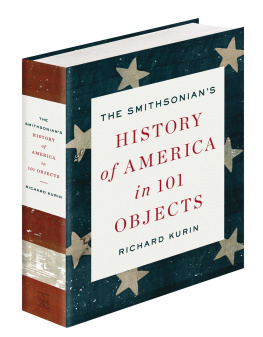WHO OWNS AMERICAS PAST?

WHO OWNS AMERICAS PAST?
The Smithsonian and the Problem of History
ROBERT C. POST

2013 The Johns Hopkins University Press
All rights reserved. Published 2013
Printed in the United States of America on acid-free paper
9 8 7 6 5 4 3 2 1
The Johns Hopkins University Press
2715 North Charles Street
Baltimore, Maryland 21218-4363
www.press.jhu.edu
Library of Congress Cataloging-in-Publication Data
Post, Robert C.
Who owns Americas past? : the Smithsonian and the problem
of history / Robert C. Post.
pages cm
Includes bibliographical references and index.
ISBN -13: 978-1-4214-1100-2 (hardcover : alk. paper)
ISBN -10: 1-4214-1100-8 (hardcover : alk. paper)
ISBN -13: 978-1-4214-1101-9 (electronic)
ISBN -10: 1-4214-1101-6 (electronic)
1. Smithsonian InstitutionHistory. 2. Public historyUnited States.
3. MuseumsSocial aspectsUnited States. 4. MuseumsPolitical
aspectsUnited States. I. Title.
Q11.S8P67 2013
069.09753dc23 2013004825
A catalog record for this book is available from the British Library.
Frontispiece: Faces of the Smithsonian new and old: the entrance to the subterranean S. Dillon Ripley Center, the quadrangle kiosk, completed in the 1980s, and, beyond, the Castle, completed in the 1850s. (Smithsonian Institution Archives, Image No. 96-1386)
Special discounts are available for bulk purchases of this book.
For more information, please contact Special Sales at 410-516-6936 or specialsales@press.jhu.edu.
The Johns Hopkins University Press uses environmentally friendly book materials, including recycled text paper that is composed of at least 30 percent post-consumer waste, whenever possible.
FOR DIAN
PREFACE
What do people say casually when they hear you work in a museum? Oh, you work at the Smithsonian? How interesting
S. DILLON RIPLEY , The Sacred Grove, 1969
A while back, I was doing research in the Smithsonian Institution Archives when an exhibit called Americas Smithsonian returned to Washington after a coast-to-coast tour. Its closing venue was the S. Dillon Ripley Center, named for the ornithologist who led the Smithsonian as its secretary for twenty years, from 1964 to 1984, longer and more eventfully than any other secretary except the first, Joseph Henry, who held office from 1846 to 1878. The Ripley Center is a subterranean world entered through a kiosk on the Mall, which leads you to a long escalator ride down. I had read reviews of Americas Smithsonianpanned in New York, a hit in Los Angelesbut I had not seen it myself. So one afternoon, I signed out of the archives, then in the old Arts and Industries Building, walked over to the kiosk next to the Castle, the institutions red sandstone signature, and descended.
Even though funds had run short and the sixty-horse carousel seen on the tour was now missing, I could believe the publicity about this being the largest collection of national treasures ever exhibited outside the But I was an old hand at the Smithsonian, and jaded, and so I hurried through. I paused at Alan Shepherds Freedom 7 spacecraft and the red, white, and blue Pontiac in which Richard Petty was said to have won his two-hundredth NASCAR race, the Firecracker 400 at Daytona. What captured most of my attention, however, was an adventuresome infomercial for Trans World Airlines ( TWA ) on a video that commanded the entrance to the gallery. In one final flight of corporate optimism (it declared bankruptcy for the third and last time soon afterward), TWA had helped finance the Smithsonians 150th anniversary celebration as a $10 million donor to its Corporate Partner Program, created to assist the Institution in its marketing objectives. As dubbed by a critic in California, Americas Smithsonian was the gonzo centerpiece of that celebration.
Then I headed for the escalator, which surfaces near a different escalator just across Jefferson Drive, this one connecting with the Smithsonian Metrorail station. As I reached the top, a man headed the other way with his family called over, Is there anything down there?
A big exhibit, I answered.
Of what? he asked.
All I could say was All sorts of things. I knew this would be of no help to anyone trying to apportion time late in the day among a dozen attractions along the Mall. I had noticed Frank Lloyd Wright furnishings from the Imperial Hotel in Tokyo, Jacqueline Kennedys inaugural gown, the gloves laced on Muhammad Ali before he fought George Foreman in Zaire, and several jackets: one worn by Chuck Yeager when he broke the speed of sound, another worn by Harrison Ford in the Indiana Jones movies, another by Cesar Chavez amid California lettuce fields. There was art by Richard Estes and Andy Warhol, and there were specimens from the natural history collectionsmastodon teeth, dinosaur skulls, and exotic minerals, including one called Smithsonite. But most prominent were objects from the diverse technological realms that had always comprised the Smithsonians richest collections. Some were prominent simply because they were largeFreedom 7 and the Apollo 14 command module Kitty Hawk, a lunar rover, an Apollo 15 space suit, a Tucker car of the future, and the NASCAR Pontiacsome not large but prominent anyway: a compass from the Lewis and Clark expedition, an Altair microcomputer, and a Jarvik heart, as well as even smaller items labeled Morse Telegraph Key, Bell Box Telephone, and Edison Light Bulb. There was also a Star Trek phaser, Judy Garlands ruby slippers, and Kermit the Frog.
So many different kinds of things, some unique like Freedom 7, many not at allnot even the ruby slippers, a mild embarrassment when another pair turned up in a Christies auctionand I really had no answer to whats down there? except for an unhelpful youll have to see for yourself.

THIS IS A BOOK ABOUT THE CHANGING WAYS in which the Smithsonian Institution has put historical artifacts on display. In the 1850s, when John Wesley Powell was first shown ethnological specimens arrayed in the East Hall of the Castle, he called what he saw interesting flotsam and jetsam. There were things that caught his eye, of course, but little or no attempt to explain their meaning or relate them one to another. In Americas Smithsonian, only the TWA video seemed purposeful (Fly TWA to Faraway Places!); the artifacts, though artfully posed and illuminated, were displayed in much the same mode as what Powell had seen long ago. The assumption was that people would find them interesting, as Powell did. By the time Secretary Ripley mentioned that word, interesting, when he wrote The Sacred Grove, he knew that an artifact became a national treasure, any artifact, solely by virtue of being in the Smithsonian. This had long been true for the technological devices that dominated Americas Smithsonian, all of them perceived as engines of human progress. It was now true even for props from television shows, like the phaser, because of their instant connection with people.
In the 1950s, with the emergence of professional designers, and especially with the move into the spacious new Museum of History and Technology ( MHT ) in the early 1960s, there were efforts to incorporate artifacts into historical narratives by means of scripts with silk-screened labels that not only identified objects but might also address their meaning. Hence, along with a Railroad Hall in MHT , there was a synoptic exhibit called
Next page







